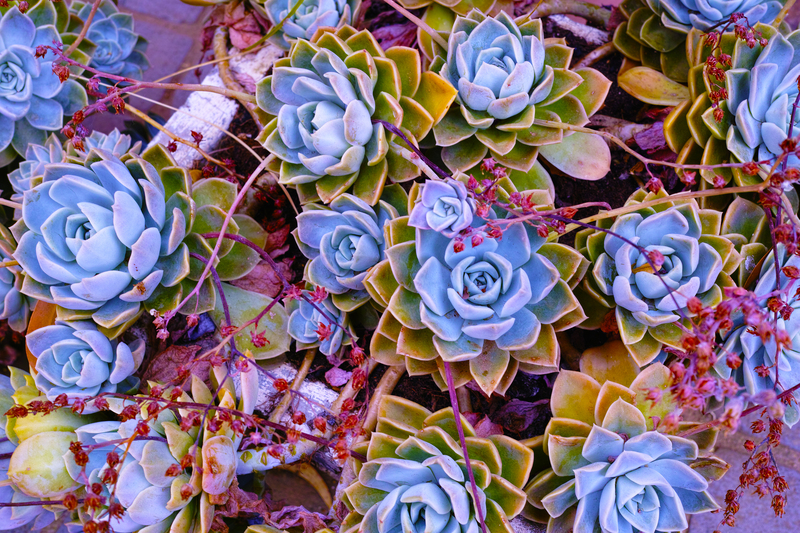Strike the Balance: Low Maintenance and Cost-Effective Gardening
Posted on 11/06/2025
Strike the Balance: Low Maintenance and Cost-Effective Gardening
Are you dreaming of a beautiful, lush landscape without the time-consuming chores and hefty costs? Low maintenance and cost-effective gardening is more than just a trend--it offers a sustainable solution for modern gardeners who want attractive outdoor spaces while minimizing both work and expenses. In this comprehensive guide, we'll explore how to create a thriving, easy-care garden that won't break the bank or consume all your weekends.

Why Choose Low Maintenance, Cost-Effective Gardening?
Beautiful gardens don't have to be high-maintenance or expensive. In fact, a well-planned, low-care garden can save time, money, and reduce your environmental footprint. Here are some vital reasons to consider this approach:
- Time-saving: Spend less time on chores, more time enjoying your garden.
- Budget-friendly: Lower costs for water, fertilizer, and replacements.
- Eco-friendly: Reduced need for chemicals and resources.
- Sustainable beauty: A balanced, thriving garden with fewer interventions.
Key Principles of Low Maintenance, Cost-Effective Gardening
To strike the perfect balance between minimal effort and low cost, start with these core principles:
- Plan before you plant
- Choose the right plants and materials
- Reduce lawn areas
- Optimize watering and feeding
- Encourage biodiversity
- Implement smart landscaping techniques
Step 1: Smart Garden Planning
Assess Your Space
Start by analyzing your outdoor area. Observe sunlight, shade, soil quality, and moisture levels. Understanding your garden's microclimates helps you choose suitable, resilient plants. Sketch a simple layout to visualize beds, paths, and features.
Set Realistic Goals
Do you want a space for relaxation, entertaining, or growing edibles? Consider your time, budget, and desired level of involvement:
- How many hours can you dedicate each week?
- What features are most important to you?
- What is your annual gardening budget?
Step 2: Selecting Easy-Care, Budget-Friendly Plants
Top Choices: Perennials and Natives
Perennials are long-lasting, coming back year after year with minimal care. Native plants, adapted to your local climate and soil, generally thrive with less water and fewer chemicals. When planning a low maintenance, cost-effective garden, prioritize these options:
- Lavender: Aromatic, drought-tolerant, and visually stunning.
- Daylilies: Hardy, colorful blooms requiring little attention.
- Yarrow: Tough, versatile, and attracts pollinators.
- Native grasses: Sustainable ground cover and movement in the garden.
- Succulents: Water-wise and ideal for low care gardens.
- Salvia: Reliable, low-water perennial with long blooming seasons.
Low Maintenance Edibles
You can enjoy productivity and beauty without extra effort or cost. Consider these easy edibles:
- Herbs (mint, chives, rosemary): Require little, provide lots.
- Rhubarb: Returns annually and yields heavily.
- Berry bushes (currants, raspberries): Minimal care, generous output.
- Zucchini: Prolific with little intervention.
Plant in Groups
Grouping plants with similar needs minimizes care. This technique, called hydrozoning, is a smart way to strike a balance between beauty and functionality. Plant sun-lovers together and shade-dwellers in the same zones.
Step 3: Lawn Reduction for Effortless Upkeep
Lawns are often the most demanding element of a landscape, consuming water, fertilizers, and energy. Reduce your lawn area to decrease costs and work. Replace grass with:
- Flowering ground covers (creeping thyme, vinca)
- Mulched beds with shrubs and perennials
- Gravel or stone paths
- Patios and seating areas for entertaining
Alternative Lawns
If you love green expanses, consider low maintenance grass species or alternatives such as clover, buffalo grass, or eco-lawns. These require less mowing, water, and fertilizer.
Step 4: Smart Watering for Healthy, Cost-Effective Gardens
Mulching
A thick layer of mulch (2-4 inches) around plants:
- Suppresses weeds
- Retains moisture
- Regulates soil temperature
- Adds organic matter
Use free or low-cost mulch materials such as shredded leaves, grass clippings, or bark chips.
Drip Irrigation & Watering Techniques
*Drip irrigation systems* target plant roots, delivering water efficiently and reducing waste. For an even more budget-conscious solution:
- Water early in the morning or late in the evening to minimize evaporation.
- Collect rainwater in barrels for free, eco-friendly irrigation.
- Group drought-tolerant species together to further economize water use.
Step 5: Soil Health -- The Low-Maintenance Foundation
Healthy soil is the backbone of any easy care and cost-effective garden. Invest time upfront for long-term savings:
- Add compost: Homemade compost from kitchen and garden waste improves fertility for free.
- Avoid chemicals: Fertilizers and pesticides can be costly and harm beneficial organisms.
- Mulch generously: Reduces the need for frequent watering and feeding.
Soil Testing
Test soil before making amendments. Local extension offices often offer low-cost testing, helping you avoid unnecessary and expensive treatments.
Step 6: Practical Tips for Minimal Effort Garden Care
- Weed prevention: Mulch and ground covers keep weeds at bay.
- Choose slow-growing shrubs: These rarely need pruning.
- Automate: Consider battery operated timers for watering systems.
- Use durable materials: Opt for long-lasting paving, borders, and structures to avoid replacement costs.
- Seasonal clean-up: One major clean-up each season can keep the garden in great shape with minimal regular work.
Step 7: Budget-Friendly DIY Solutions
Repurpose and Reuse
A cost-effective garden can also be creative. Repurpose old materials:
- Use reclaimed bricks for edging.
- Turn pallets into vertical gardens.
- Convert containers into planters.
- Collect seeds and cuttings from friends, neighbors, or community sales.
Create Your Own Compost
Home composting cuts down on waste and expenses:
- *Kitchen scraps* provide free plant food.
- *Leaf litter* can be composted or used as mulch.
- *Grass clippings* are excellent for quick, nitrogen-rich compost.
Step 8: Encourage Wildlife for a Balanced Ecosystem
A healthy, balanced ecosystem in your garden reduces pest and disease problems, minimizing the need for costly interventions. Tips:
- Plant pollinator-friendly flowers (coneflower, bee balm).
- Install a bird bath or feeder.
- Provide shelter (houses for bees, piles of logs for insects).
- Avoid pesticides that harm helpful insects.
*Welcoming wildlife creates an almost self-sustaining garden that needs very little human interference.*
Step 9: Seasonal and Year-Round Care Tips
Spring Tasks
- Mulch, weed, and divide overgrown perennials.
- Start compost bins or refresh existing ones.
- Plan new plantings for optimal rainfall periods.
Summer Tasks
- Monitor watering, especially for new plantings.
- Deadhead flowers to encourage more blooms.
- Enjoy the bounty of herbs, vegetables, and pollinators.
Autumn Tasks
- Collect seeds for next season.
- Rake leaves for mulch or compost.
- Cut back dead stems to tidy up, leaving some for wildlife habitat.
Winter Tasks
- Sharpen and oil tools to extend their life.
- Check stored bulbs and tubers.
- Review and plan improvements for even lower maintenance next year.

Common Mistakes to Avoid in Low Maintenance Gardening
- Overplanting or tight spacing: Leads to crowding and higher disease risk.
- Irrational plant choices: Avoid exotics that require special care and climate.
- Misusing chemicals: Overuse increases costs and reduces ecosystem resilience.
- Neglecting soil preparation: Leads to poor growth and more upkeep.
- Ignoring local climate: Gardening against your environment leads to excessive work and expense.
Conclusion: Enjoy an Attractive, Easy-Care and Affordable Garden
By following these practical steps for low maintenance and cost-effective gardening, you can transform your yard into a stress-free sanctuary. Thoughtful plant selection, soil health, water efficiency, and creative reusing will help you enjoy a lush and vibrant garden without the exhausting chores or financial burden.
Garden smarter, not harder. With these tips, you'll spend more time relaxing and less time laboring--while also saving money and supporting local ecology. Whether you're a beginner or looking to redesign your space, striking the right balance means a flourishing, worry-free oasis is within reach!
Ready to start your own effortless, budget-friendly garden?
Embrace these balanced gardening principles and watch your outdoor space bloom with beauty--and ease! For further ideas and plant lists, explore your local extension service or gardening club, and remember: successful gardening is a blend of smart choices and creativity.

